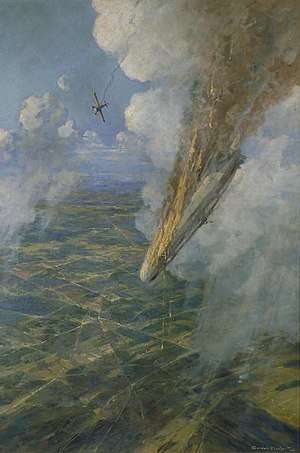LZ 37
The airship LZ 37 was a World War I Zeppelin of the German Kaiserliche Marine (Imperial Navy). It was the first Zeppelin to be brought down during the war by an enemy plane on the night of 6 to 7 June 1915.[1]
| LZ 37 | |
|---|---|
 | |
| Artist's impression of the destruction of German Zeppelin LZ 37 by Sub-Lieutenant Reginald Warneford on 7 June 1915. | |
| Role | Reconnaissance and bombing |
| National origin | |
| Type | M-Class Zeppelin |
| Manufacturer | Luftschiffbau Zeppelin at Friedrichshafen |
| Construction number | LZ 37 |
| First flight | 4 March 1915 |
| Owners and operators | |
| In service | 4 March 1915 – 7 June 1915 |
| Flights | 14 |
| Fate | Shot down, 7 June 1915 |
History
In 1915 Zeppelins were first used by Germany for strategic bombing of the United Kingdom and France.
LZ 37 was part of a raid with Zeppelin LZ 38 and LZ 39. While returning, she was intercepted in the air by Reginald Warneford in his Morane Parasol during its first raid on Calais on 7 June 1915.[2][3] Warneford dropped six 20 pounds (9.1 kg) Hales bombs on the zeppelin which caught fire and crashed into the convent school of Sint-Amandsberg, next to Ghent, Belgium (51°3′43.2″N 3°44′54.7″E), killing two nuns. The commander of LZ 37, Oberleutnant van der Haegen, and seven members of the crew were killed. One crew member, Steuermann Alfred Mühler, miraculously survived with only superficial burns and bruises when he was precipitated from the forward gondola, landing in a bed.[4] It was the first victory of a heavier-than-air aircraft over a lighter-than-air dirigible. Warneford was awarded the Victoria Cross for his achievement.
The LZ 37 was based in Gontrode, Belgium (airport location: 50°58′54.6″N 3°47′17.1″E).
Specifications
Data from "The Zeppelin Airships - Part Two: Zeppelins of the Great War 1914–1918". Puget sound airship society. Retrieved 28 January 2011.
General characteristics
- Crew: 28
- Length: 163.37 m (536 ft 0 in)
- Diameter: 18.7 m (61 ft 4 in)
- Volume: 33,780 m3 (1,126,000 cu ft)
- Empty weight: 17,588 kg (38,775 lb)
- Useful lift: 8,520 kg (18,780 lb)
- Powerplant: 4 × Maybach MC-X , 155 kW (210 hp) each
Performance
- Maximum speed: 96 km/h (60 mph, 52 kn)
Armament
- Four machine-guns
Notes
- Stephenson 2004, p. 16.
- Piet, Dhanens. "Zeppelin LZ 37 te Sint-Amandsberg". Luchtvaartgeschiedenis.be (in Dutch). Retrieved 2019-12-29.
- Dhanens, Piet (2008). Een eeuw luchtvaart boven Gent (in Dutch). 1. Erembodegem (Aalst): Flying Pencil. ISBN 978-90-78878-04-9. OCLC 1074669308.
- History of the First World War, vol. 3, pp. 986.
References
- Castle, Ian (2008). London 1914–17: The Zeppelin Menace. Oxford, UK New York, NY. USA: Osprey Pub. ISBN 9781846032455.
- Brooks, Peter (1992). Zeppelin: Rigid Airships, 1893-1940. Washington, D.C: Smithsonian Institution Press. ISBN 9781560982289.
- Faulkner, Neil (2008). In Search of the Zeppelin war: The archaeology of the First Blitz. Stroud: Tempus. ISBN 9780752441825.
- Stephenson, Charles (2004). Zeppelins: German Airships 1900–40. Oxford: Osprey. ISBN 1841766925.CS1 maint: ref=harv (link)
- "Puget Sound Airship Society: Zeppelin Airships 1900–1917". pugetairship.org. 2008. Retrieved 29 June 2013.
External links
- Braeckman, Ann (20 January 2011). "Canvasprogramma 'Publiek Geheim' belicht Gontrode (Melle) - Het Nieuwsblad". nieuwsblad.be (in Dutch). Retrieved 29 June 2013.
- "Bunkers op voormalig WOI-WOII vliegveld - Hangar Flying". aviationheritage.eu. 2013. Retrieved 29 June 2013.
- Ghent, Thomas (2012). "KG III Der Englandflieger". thomasgenth.de (in German). Retrieved 29 June 2013.
- Whitehouse, Arch (2012). "Zeppelin Raiders - History of British Pilots who Shot Down German Airships in WW1". acepilots.com. Retrieved 29 June 2013.
- "Bekijk onderwerp - LZ 37 Monument Westerbegraafplaats". forumeerstewereldoorlog.nl. 2007. Retrieved 29 June 2013.
- "Vliegveld te Lemberge / Gontrode". forumeerstewereldoorlog.nl. 2007. Retrieved 29 June 2013.
- "Zeppelinsteine und anderes". luftschiffharry.de. 2013. Archived from the original on 11 February 2013. Retrieved 29 June 2013.
- "De val van de Zeppelin". nieuwsblad.be (in Dutch). 8 May 2008. Retrieved 29 June 2013.
- Colon, Raul (2007). "The Zeppelin is Down". aviation-history.com. Retrieved 29 June 2013.